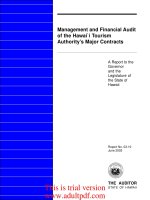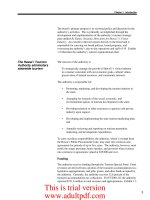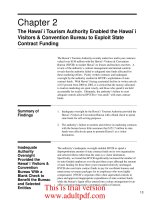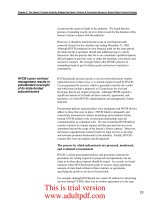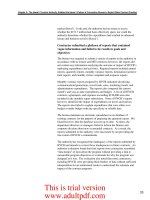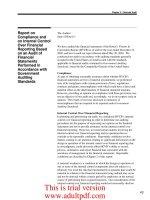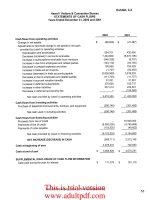Management and Financial Audit of the Hawaii Tourism Authority’s Major Contracts A Report _part2 ppt
Bạn đang xem bản rút gọn của tài liệu. Xem và tải ngay bản đầy đủ của tài liệu tại đây (43.98 KB, 10 trang )
3
Chapter 1: Introduction
The board’s primary purpose is to set broad policy and direction for the
authority’s activities. This is primarily accomplished through the
development and implementation of the authority’s tourism strategic
plan entitled Ke Kumu: Strategic Directions for Hawai`i’s Visitor
Industry. An executive director reports directly to the board and is
responsible for carrying out board policies, board programs, and
overseeing the authority’s day-to-day operations and staff of 19. Exhibit
1.2 illustrates the authority’s current organizational chart.
The mission of the authority is:
To strategically manage the growth of Hawai`i’s visitor industry
in a manner consistent with our economic goals, cultural values,
preservation of natural resources, and community interests.
The authority is responsible for:
• Promoting, marketing, and developing the tourism industry in
the state;
• Arranging for research of the social, economic, and
environmental aspects of tourism development in the state;
• Providing technical or other assistance to agencies and private
industry upon request;
• Developing and implementing the state tourism marketing plan;
and
• Annually reviewing and reporting on tourism promotion,
marketing, and development expenditures.
To carry out these responsibilities, the authority, which is exempt from
the Hawai`i Public Procurement Code, may enter into contracts and
agreements for periods of up to five years. The authority, however, must
notify the senate president, house speaker, and governor when it enters
into contracts or agreements valued at $25,000 and over.
Funding
The authority receives funding through the Tourism Special Fund. Fund
revenues are derived from a portion of the transient accommodations tax;
legislative appropriations; and gifts, grants, and other funds accepted by
the authority. Currently, the authority receives 32.6 percent of the
transient accommodations tax collections. For FY2001-02, the authority
reported $131.8 million in total revenues and appropriations. Exhibit 1.3
The Hawai`i Tourism
Authority administers
statewide tourism
This is trial version
www.adultpdf.com
4
Chapter 1: Introduction
Executive Director,
HTA
Executive
Secretary
Secretary Receptionist
Marketing Office
Product
Development Office
Administration
Office
Communications
Office
Director of Tourism
Marketing
Administrative
Assistant II
Sports Events
Manager
Tourism Specialist
III
Tourism Program
Officer
Chief
Administrative
Officer
Communications
Director
Product
Development
Coordinator
Tourism Specialist
Secretary II
Budget Fiscal
Officer
Project Manager
Contracts
Specialist
Administrative
Assistant I
Information
Coordinator
Executive Office
Source: Hawai`i Tourism Authority
Exhibit 1.2
Hawai`i Tourism Authority - Organizational Chart
This is trial version
www.adultpdf.com
5
Chapter 1: Introduction
illustrates the revenues and appropriations received by the authority from
FY1999-2000 to FY2001-02.
Major contractors
Section 23-13, HRS, directs the Auditor to conduct a financial and
management audit of the authority’s “major contractors.” A major
contractor is a contractor to whom a contract or agreement has been
awarded that is valued in excess of $15 million. For this audit, we
interpreted the $15 million threshold to include the total compensation a
contractor would receive over a multi-year contract and not just the
annual compensation. The authority had four contracts with the
following contractors that met the $15 million threshold:
1. Hawai`i Visitors & Convention Bureau (HVCB). The authority had
two major contracts with HVCB—one for leisure marketing and one
for meetings, conventions and incentives. The value of the leisure
contract was $129 million; the meetings, conventions and incentives
contract was $22.7 million. Both contracts were multi-year contracts
beginning January 1, 2000 and ending December 31, 2002.
2. SMG. The authority contracts with SMG to manage and operate the
Hawai`i Convention Center. The contract’s initial period was June
28, 1996 to June 30, 1999. A first option period extended the
contract through June 30, 2003. The authority began operating the
convention center on July 1, 2000. Prior to that date, the contract
Exhibit 1.3
Hawai`i Tourism Authority
Revenues and Appropriations, FY1999-2000 to FY2001-02
FY1999-2000 FY2000-01 FY2001-02
Revenues:
Tourism Special Fund $ 63,887,000 $ 67,145,000 $ 59,743,000
Interest/miscellaneous receipts $ 248,000
$ 528,000 $ 971,000
Total revenues $ 64,135,000 $ 67,673,000 $ 60,714,000
Appropriations:
Regular session $ 60,000,000 $ 61,000,000 $ 61,057,000
Special session
$ - $ -
$ 10,000,000
Total Appropriations $ 60,000,000 $ 61,000,000 $ 71,057,000
Source: Hawai`i Tourism Authority
This is trial version
www.adultpdf.com
6
Chapter 1: Introduction
was managed by the Convention Center Authority. The value of the
SMG contract under the authority’s management, from July 1, 2000
through June 30, 2003, is about $39.5 million.
3. National Football League (NFL). This contract, which runs from
April 1, 2000 through March 31, 2005, is for marketing the NFL Pro
Bowl games in Hawai`i. The value of this five-year contract is
$23.75 million.
For purposes of this audit, we focused exclusively on the authority’s two
contracts with HVCB.
As a private, nonprofit, tax-exempt 501(c)(6) corporation, the HVCB
promotes leisure and business travel to Hawai`i, including meetings and
conventions. HVCB also acts as a catalyst and advocate for improving
and expanding Hawai`i’s wide-ranging product offerings and
experiences, while creating economic opportunities through tourism.
History
Established in 1903, HVCB, then known as the Hawai`i Visitors Bureau,
is the oldest tourism organization in the Pacific region and began as a
committee of the Honolulu Chamber of Commerce. It received direct
territorial appropriations until 1959 when it became a nonprofit
corporation. In that same year, the Legislature passed Act 16, which
authorized the newly created Department of Planning and Economic
Development (now the Department of Business, Economic Development
and Tourism) to contract with the bureau for marketing services. In July
1996, the bureau’s name was officially changed to the Hawai`i Visitors
& Convention Bureau, to reflect a new emphasis on business/meeting
travel and responsibility for marketing the Hawai`i Convention Center.
Resources
Today, HVCB has a worldwide presence. In addition to its corporate
headquarters in Honolulu, the bureau also maintains offices on each of
the major neighbor islands and around the world. In the United States,
the bureau maintains offices in Salinas, California; San Diego,
California; Chicago, Illinois; and Arlington, Virginia.
The bureau also maintains four foreign offices, two in Japan (Tokyo and
Osaka) and two in the People’s Republic of China (Beijing and
Shanghai).
HVCB representatives can be found in Canada, Germany, United
Kingdom, Australia, New Zealand, Korea, Taiwan, Hong Kong, and
Uruguay. HVCB’s organizational chart is shown in Exhibit 1.4.
The Hawai`i Visitors &
Convention Bureau is
the State’s official
tourism marketing
agency
This is trial version
www.adultpdf.com
7
Chapter 1: Introduction
NORTH AMERICA MARKETING
(USW, USE, CND, MME)
DEVELOPING
INTERNATIONAL MARKETS
(EUR, ASI, ANZ, LTA, MME)
JAPAN MARKETING
(JPN)
MEETINGS, CONVENTIONS &
INCENTIVES
(HCC,CMI)
HVCB BOARD
Executive
Committee
Island Chapter
Boards
HVCB
President & CEO
(MME)
LEISURE/BUSINESS
Major Market Areas
ISLAND CHAPTERS
Big Island
Kaua`i
Maui (Moloka`i and Lana`i)
O`ahu
(All MMAs)
GLOBAL
MARKETING
INITIATIVES
FINANCE &
CORPORATE
SERVICES
(MME)
E-MARKETING
(all MMAs)
GLOBAL CORP COMMUNICATIONS
& PARTNERSHIPS
(all MMAs)
CUSTOMER RELATIONSHIP
MANAGEMENT
(all MMAs)
Exhibit 1.4
Hawai`i Visitors & Convention Bureau
Organizational Chart
Legend
ANZ - Oceania (Australia/New Zealand)
ASI - Asia
CMI - Corporate Meetings & Incentives
CND - Canada
EUR - Europe
HCC - Hawai`i Convention Center
JPN - Japan
LTA - Latin America
MMA - Major Market Area
MME - Major market area expenditures that
cannot be easily or efficiently delineated
or defined as belonging to one specific
MMA and/or crossed over several
functional categories
USE - US East
USW - US West
Source: Hawai`i Visitors & Convention Bureau
This is trial version
www.adultpdf.com
8
Chapter 1: Introduction
For calendar year 2002, HVCB reported a total budget of about $68.8
million, of which $47.9 million, or 70 percent, was derived from state
funds and approximately $21 million, or 30 percent, was reportedly
derived from private sources. Private fund sources included $2.6 million
in membership fees (12 percent), $12 million worth of cooperative
marketing (57 percent), and $6 million worth of in-kind contributions (29
percent). Of these amounts, only the $2.6 million in membership fees
represents private cash funding. In effect, private sources account for
only a fraction of HVCB’s overall cash funding. We explain further
below.
Cooperative marketing occurs when HVCB and private companies pool
funds to leverage buying and marketing power. For example, if HVCB
develops a two-page advertising insert for a travel magazine, other
companies may opt to add their advertisements to the insert. The insert,
which may have grown to four pages, will then strengthen the message of
Hawai`i as a travel destination. An example of an in-kind contribution is
a hotel sleeping or meeting room made available at no charge to HVCB
for a Japanese press tour in Hawai`i. Cooperative marketing and in-kind
contributions “revenues” are the estimated value of the services,
contributions, and support that HVCB receives and do not represent
actual cash funding. Therefore, private sources account for only about 5
percent of all cash funding that HVCB receives. State contract funds
account for about 95 percent of HVCB’s cash funding. Exhibit 1.5
illustrates HVCB’s funding sources from 2000 through 2002.
State contracts
The authority’s two three-year marketing contracts with HVCB recently
ended on December 31, 2002. The $22.7 million meetings, conventions
and incentives contract required HVCB to develop and carry out a
marketing plan that targeted sales and marketing of the Hawai`i
Convention Center and other meeting and convention facilities on all
islands. During CY2002, HVCB budgeted $8.0 million to market the
convention center and other meeting and convention facilities. Exhibit
1.6 illustrates HVCB’s meetings, conventions and incentives
expenditures for CY2002.
The $129 million leisure contract required HVCB to develop and
implement an annual comprehensive tourism marketing plan in
accordance with the authority’s tourism strategic plan. The annual
tourism marketing plan was to outline how HVCB would increase
Hawai`i’s promotional presence and brand entity to more globally
competitive levels in Hawai`i’s nine major market areas: Japan, Canada,
Europe, Latin America, Asia, eastern U.S., western U.S., Oceania
(including Australia and New Zealand), and other. During CY2002,
HVCB spent $35 million in state funds to market Hawai`i in these
markets. Exhibit 1.7 reflects these expenditures.
This is trial version
www.adultpdf.com
9
Chapter 1: Introduction
Exhibit 1.5
Hawai`i Visitors & Convention Bureau
Sources of Funding, CY2000 to CY2002
CY2000 CY2001 CY2002
State Funds
Leisure
Marketing $ 38,400,000 $ 39,000,000 $ 39,000,000
Transfer to Meetings, Conventions & Incentives - - (2,000,000)
Reductions - - (2,000,000)
Proviso 600,000 - -
Emergency (post 9/11/01 terrorist attack) -
7,111,840 4,888,160
Total - Leisure $ 39,000,000 $ 46,111,840 $ 39,888,160
Meetings, conventions & incentives
Hawai`i Convention Center (HCC)
Marketing $ 3,225,531 $ 3,000,000 $ 2,000,000
Supplemental - 1,000,000 -
Transfer from leisure contract - - 2,000,000
Marketing flexibility funds 1,000,000 1,000,000 2,000,000
Proviso/supplemental funds 700,000
- -
Subtotal HCC $ 4,925,531 $ 5,000,000 $ 6,000,000
Corporate meetings & incentives (CMI)
Marketing $ 1,774,469 $ 2,000,000 $ 2,000,000
Supplemental -
1,000,000 -
Subtotal CMI $ 1,774,469 $ 3,000,000 $ 2,000,000
Total - Meeting, conventions &
incentives (HCC and CMI) $ 6,700,000
$ 8,000,000 $ 8,000,000
Total State Funds: $ 45,700,000 $ 54,111,840 $ 47,888,160
Private Funds
Co-op Marketing $ 12,840,855 $ 17,576,003 $ 12,000,000
In-Kind Contributions 7,606,678 6,145,427 6,000,000
Subscriptions (Membership dues) 2,616,711 2,235,809 2,600,000
Interest 74,528 83,282 50,000
Other* 577,809
772,933 332,000
Total Private Funds: $ 23,716,581 $ 26,813,454 $ 20,982,000
Total Funds – State and Private: $ 69,416,581 $ 80,925,294 $ 68,870,160
* "Other" private funds include Aloha Concierge Program, consumption tax refund, donations, and friendship contributions
Source: Haw ai`i Visitors & Convention Bureau
Source: Hawai`i Visitors & Convention Bureau
This is trial version
www.adultpdf.com
10
Chapter 1: Introduction
Source: Hawai`i Visitors & Convention Bureau
Source: Hawai`i Visitors & Convention Bureau
Hawai`i
Convention Center
Corporate Meetings
& Incentives
Total
Advertising 531,970$ 317,060$ 849,030$
Communications/Promotions 749,633 204,642 954,275
Meeting Trade 265,479 290,965 556,444
Sales 4,362,829 1,011,605 5,374,434
Market Trends 2,960 - 2,960
Administration 153,287
109,570 262,857
Total 6,066,158$
1,933,842$ 8,000,000$
Exhibit 1.6
Hawai`i Visitors & Convention Bureau
Meetings, Conventions & Incentives Contract
Expenditures, CY2002
Exhibit 1.7
Hawai`i Visitors & Convention Bureau
Leisure Contract Expenditures, CY2002
Major Market Area
Advertising
Communications/
Promotions
Meeting
Trade
Sales
Market
Trends Admin
Total
US West 4,030,238$ 1,858,657$ 1,609,153$ 89,282$ 11,685$ 12,415$ 7,611,430$
US East 5,282,630 2,378,119 1,654,044 69,217 11,615 9,833 9,405,458
Canada 343,225 242,473 111,730 67,854 11,600 - 776,882
Japan 4,411,774 2,460,341 822,834 511,472 477 105,133 8,312,031
Europe 87,810 446,963 67,157 156,930 - - 758,860
Latin America 13,108 22,788 13,358 50,022 - - 99,276
Asia 16,376 220,440 296,288 157,350 - 160,488 850,942
Oceania 9,309 73,981 28,507 68,901 - - 180,698
Multi-area 834,681
1,162,013 683,572 1,724,780 216,053 2,383,324 7,004,423
Total 15,029,151$
8,865,775$ 5,286,643$ 2,895,808$ 251,430$ 2,671,193$ 35,000,000$
This is trial version
www.adultpdf.com
11
Chapter 1: Introduction
Previous audits revealed the State’s history of exercising inadequate
oversight of its tourism-related contracts. A previous audit also found
that HVCB had failed to fulfill its state contractual responsibilities.
Our most recent audit in 2003, Financial Audit of the Department of
Business, Economic Development and Tourism, Report No. 03-03, found
that the authority did not adequately manage its contracts. As a result,
contractors performed services prior to the execution of legally binding
contracts, contractors’ final reports were not received in a timely manner,
contracts were renewed prior to the authority’s evaluation of the quality
of the work provided, and final payment was made prior to the
completion of all required tasks. Our 2002 Management Audit of the
Hawai`i Tourism Authority, Report No. 02-04, identified serious
deficiencies in the authority’s contracting process. Specifically, the
authority could not justify the contracts it awarded and did not
adequately monitor all contracts.
In 1993, the office conducted a Management and Financial Audit of the
Hawai`i Visitors Bureau, Report No. 93-25. We found that the bureau
and the Department of Business, Economic Development and Tourism
had fallen short in fulfilling their respective responsibilities for the
State’s tourism program. The report specifically noted that the bureau
had not been submitting reports required under its state contract, and the
department had not effectively administered and monitored the bureau’s
contract.
1. Assess whether the Hawai`i Tourism Authority adequately manages
its major contracts.
2. Assess the compliance of major contractors with contract provisions
and the propriety of contract expenditures.
3. Make recommendations as appropriate.
We focused our audit on the authority’s two contracts with the Hawai`i
Visitors & Convention Bureau to provide marketing for the leisure travel
segment and for meetings, conventions and incentives from January 1,
2000 to December 31, 2002. The contracts were judgmentally selected
based on their economic significance to the authority and the state
economy and their high dollar value.
We reviewed pertinent laws, audits, reports, and studies. We
interviewed HVCB and authority personnel including HVCB’s president,
Prior audits found
numerous deficiencies
with both the authority
and the bureau
Objectives of the
Audit
Scope and
Methodology
This is trial version
www.adultpdf.com
12
Chapter 1: Introduction
chief financial officer, human resources manager, and the authority’s
executive director, chief administrative officer, and director of tourism
marketing. We reviewed HVCB’s general ledgers, account journals,
invoices, contracts, policies and procedures, and personnel information.
We also reviewed the authority’s contract files and reports, and its
policies and procedures. Our fieldwork focused on expenditures made
by HVCB’s corporate office, Tokyo office, and the Kaua‘i Visitors
Bureau from January 2002 through October 2002.
Our audit required the services of a technical consultant. We procured
the services of Nishihama & Kishida, CPA’s, Inc. The consultant
conducted a financial audit of HVCB for the calendar year ending
December 31, 2002 in accordance with generally accepted auditing
standards. The consultant also reviewed contracts entered into by HVCB
and the propriety by which HVCB managed those contracts. Finally, the
consultant assessed HVCB’s existing accounting, reporting and internal
controls, and operating procedures.
The audit was conducted from October 2002 through June 2003 in
accordance with generally accepted government auditing standards.
This is trial version
www.adultpdf.com
